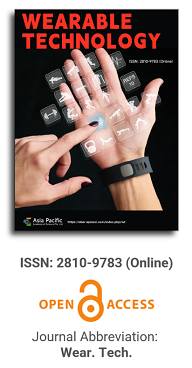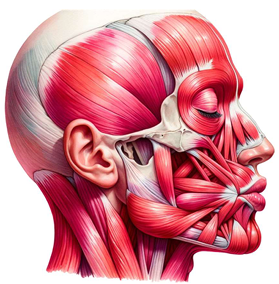

This paper delves deeply into the innovative realm of integrating human emotions with wearable technology. The primary focus is on the conceptualization and development of a kiss transfer device that harnesses the power of wearable technology to bridge the physical gap in human-human interactions. By investigating the intricate nuances of the human-human kissing process, the research seeks to replicate this intimate gesture through a technological medium. The paper not only elaborates on the anatomy, evolution, and hormonal dynamics of kissing but also underscores the transformative potential of wearable technology in capturing and transmitting these intimate moments. This exploration opens up new horizons for long-distance relationships, offering a tangible touchpoint that goes beyond traditional communication methods. Through this pioneering work, the research positions wearable technology as not just a tool for communication but as an extension of our human emotions and expressions.

The regulation of the body by smart wearable devices and their social risk progression
Vol 2, Issue 1, 2021
Download PDF
Abstract
Smart wearable devices, as one of the directions of smart terminal development, show great potential for application and penetrate into all aspects of social life. In the application of smart wearable devices, the features of body discipline such as obtaining body data precisely to complete quantified self, human–computer interaction from explicit interaction to implicit interaction, and monitoring of the body from expert dependence to technological dependence and the new human–computer relationship hidden behind them are increasingly highlighted, and the social risk concerns of smart wearable device application will also come into play, which will lead to personal privacy leakage and technological risks. The social risks arising from the disclosure of personal privacy and technological risks, the loss of human subjectivity and the degradation of working capacity, the distortion of social life and the difficulties of social interaction, the deepening of the digital divide and the widening gap between the rich and the poor, the formation of a “digital leviathan” and the potential for public safety, etc., should be of sufficient concern to society.
Keywords
References
- Mann S. Wearable computing: Toward humanistic Intelligence. IEEE Intelligent Systems 2005; 16(3): 10–15.
- Li H. From “agent” to “alternative” technology and the “obsolete” human being? China Social Science 2020; (10): 116–140, 207.
- Wu KS. Classic readings in the philosophy of technology. Shanghai: Shanghai Jiaotong University Press, 2008, pp.266–269.
- Xu X. Domain applications of wearable computing devices and their impact on information services. Library Intelligence Work 2015; (13): 74–81.
- Wiener N. Time,communication,and the nervous system. Annals of the New York Academy of Sciences 1948; 50(10): 197–220.
- Jose VD. Datafication, dataism and dataveillance: Big data between scientific paradigm and ideology. Surveillance and Society 2014; 12(2): 197–208.
- Donna H. Hominids, cyborgs and women:The reinvention of nature. (translated by Chen J, Wu YC) Zhengzhou: Henan University Press, 2012, pp. 204–253.
- Zhao FD. Sociology of the body: A new threshold for understanding contemporary society. Journal of East China University of Science and Technology. (Social Science Edition) 2012; (4):27–35.
- George MJ, Rivenbark JG, Russell MA, et al. Evaluating the use of commercially available wearable wristbands to capture adolescents’ daily sleep duration. Journal of Research on Adolescence 2019; 29(3): 613–626.
- Marx K. Economic and philosophic manuscripts of 1844. Economica 1960; 26(104): 379.
- Xu XY, Liu HZ. Philosophical implications of 3D printing technology in Heidegger’s perspective. Philosophical Studies in Science and Technology 2017; (4): 47–52.
- Liu DC, Liu JY. A classic study of the philosophy of science and technology. Beijing: People’s University of China Press, 2011, pp.126.
- Ihde D. Bodies technology. Minneapolis: University of Minnesota Press, 2002, pp.89.
- Zhou WP. Technology and the body: A Phenomenological reflection on “technological embodiment”. Zhejiang Social Science 2019; (8): 98–105,158.
- Wen CW, Lian J. The realm of clarity in technological embodiment. Studies in Natural Dialectics 2017; (5): 26–30.
- Kaelbling LP, Littman, ML, Moore AW. Reinforcement learning: A survey. Journal of Artificial Intelligence Research 1996; 4(5): 237–285.
- Mumford L. Technics and the nature of man. Nature 1965; 208(10): 923–928.
- Wu GS. Philosophy of technology: A discipline with a great future. Shanghai: Shanghai Jiaotong University Press, 1999, pp.96.
- Ulrich B. Risk society: The new road to modernity. (translated by Zhang WJ, He BW) Nanjing: Yilin Publishing House, 2018, pp.14.
- John CH. The future of loss of control. (translated by Tong, Lin.) Beijing: CITIC Press, 2017, pp.76.
- Eberl JTA. Thomistic appraisal of human enhancement technologies. Theoretical Medicine and Bioethics 2014; 35(4): 289–310.
- Michael PL. The truth about loss of control–Why you know so much, but so little wisdom. (translated by Zhao Yanan) Beijing: Electronic Industry Press, 2017, pp.46.
- Herbert Marcuse. The man of unidirectionality. (translated by Liu J.) Shanghai: Shanghai Translation Press, 2008, pp.10.
- Chen CS. Introduction to the Philosophy of Technology. Beijing: Science Press, 1999, pp.240.
- Yan KR. The alienation of artificial intelligence technology and its essential source. Journal of Shanghai Normal University (Philosophy and Social Science Edition) 2020; (3): 100–107.
- Yuval H. A brief history of the future. (translated by Lin JH) Beijing: Electronic Industry Press, 2017, pp. 292.
- Mary S. Frankenstein. (translated by Zhang ZZ) Beijing: China Translation Press, 2016, pp.69–71.
- Thomas H. Leviathan. (translated by Lai SF, Lai TP) Beijing: The Commercial Press, 2017, pp. 138.
- Mouzelis NP. Post–marxist alternatives: The construction of social orders. London: Palgrave Macmillan, 1999, pp. 45–92.
- John M. A Brief History of Artificial Intelligence. (translated by Guo X). Hangzhou: Zhejiang People’s Publishing House, 2017, pp. 125.
- Ray K. The singularity is near. (Translated by Li QC, Dong ZH, Tian Y) Beijing: Machinery Industry Press, 2011, pp. 133.
- Anthony G. The third way and its criticism. (translated by Sun XD). Beijing: Party School of the Central Committee of the Communist Party of China Press, 2002, pp. 139.
Supporting Agencies
Copyright (c) 2021 Xiangyun Xu, Wei Ma

This work is licensed under a Creative Commons Attribution 4.0 International License.

Prof. Zhen Cao
College of Information Science & Electronic Engineering, Zhejiang University
China, China
Processing Speed
-
-
-
- <5 days from submission to initial review decision;
- 62% acceptance rate
-
-
Asia Pacific Academy of Science Pte. Ltd. (APACSCI) specializes in international journal publishing. APACSCI adopts the open access publishing model and provides an important communication bridge for academic groups whose interest fields include engineering, technology, medicine, computer, mathematics, agriculture and forestry, and environment.





